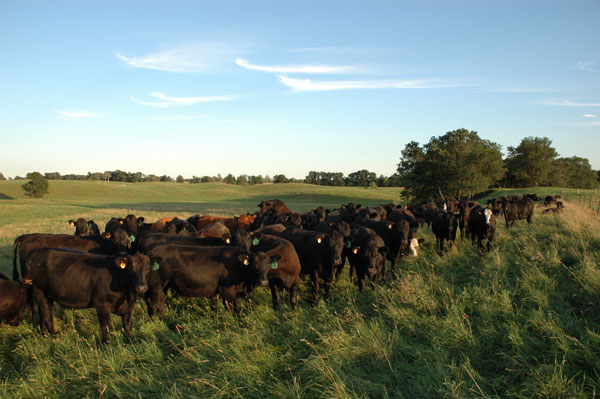Kochia – The Good, The Bad And The Ugly
Kochia can be a sound grazing alternative if managed correctly. If not, it can be the genesis of a major grazing wreck.

One of its common names is fireweed, which is fitting, and not just because of its bright red fall foliage. It’s also appropriate because, while kochia has good forage value and can be an important part of your overall forage management, it can be the match that starts the dry tinder of a forage-related wreck if managed incorrectly.
Kochia is an invasive range plant first introduced in the U.S. around 1900 as an ornamental. But because of its drought-hardiness and ability to grow in very poor soils, it escaped and now grows throughout much of the U.S. It’s particularly well-suited to semi-arid climates because of its drought, disease and insect resistance, and alkaline soil pH tolerance.
Nicknamed “poor man’s alfalfa” among others, kochia usually has good forage value, often containing 11-22% crude protein depending upon soil nitrogen content and stage of maturity at the time of grazing initiation or harvesting as hay, according to Larry Hollis, Kansas State University Extension beef veterinarian. Well-managed kochia grazing, or feeding timely harvested Kochia hay, usually results in good livestock performance.
If you don’t manage it correctly, however, you can be playing with fire.
You might also like:
Is the New York Times naive about MARC or intentionally misleading?
Prevention and treatment of cow prolapse
7 U.S. cattle operations honored for stewardship efforts
9 lessons to make your ranching life richer
If kochia plants are allowed to grow more than 18-26 in. tall or begin to develop seedheads; are drought-stressed shortly before grazing or haying occurs; or if insufficient cattle are placed in the field to keep the kochia grazed below recommended heights, various toxicity problems may occur with both harvested and grazed plants, Hollis says.
Shortly following periods of drought stress, nitrate toxicity may occur. However, the most common problem occurs as the plants approach maturity, because the seed head is the most toxic part of the plant. Oxalate accumulations as high as 6-9% (100% DM basis) are not uncommon in nearly mature green plants. Oxalates absorb into the circulation and bind with calcium to form insoluble calcium oxalate. If consumed rapidly and in very high quantities, it can lead to hypocalcemia.
“A more common problem, however, is the accumulation of calcium oxalate crystals in the kidneys, which causes kidney failure,” Hollis says. The toxin also can also cause liver failure in cattle, sheep and horses.
These problems typically have occurred when animals have been moved off well-grazed or drought-limited native pasture and into a post-harvest wheat field, an old corral or a drylot where kochia plants have grown up and appear to be a ready source of forage for hungry livestock. Toxicity especially becomes problematic if the diet is made up almost exclusively of kochia, and animals have been consuming it for more than 30-60 days.
According to the Alternative Field Crops Manual, published by Wisconsin and Minnesota Extension, livestock should not graze kochia for more than 90-120 days to prevent oxacalate toxicity. Rotational grazing with non kochia-infested pastures can also help prevent potential toxicity.
When harvested for hay or silage, cut kochia when it’s 18-26 in. high and before it has produced seed heads.
One of the first signs commonly reported with oxalate-induced kochia toxicity is increased water consumption as kidney function is altered by the toxin. This probably won’t be noticed unless a producer is hauling water to his livestock and notices a sudden increase in water needs.
Another common sign is photosensitization as a result of liver failure, which appears as sunburning, particularly of lighter-skinned animals, or white patches of skin on multi-colored animals. Skin areas unprotected or poorly protected by hair, such as around the eyes and the udders, are usually most severely affected.
The safest way to feed kochia is in the smallest amounts possible, according to “Feeding Kochia to South Dakota Livestock,” a South Dakota State University fact sheet. Alternate feeding and dilution feeding are recommended; feeding kochia in an alternating pattern such as every other week, for example. However, it’s best to avoid rations containing more than 50% kochia, according to the fact sheet.
If toxicity signs are noted, animals should be immediately removed from kochia fields, or feeding kochia hay should be stopped and animals given access to high-quality feedstuffs, Hollis says. Many of the animals not visibly showing signs of the toxin will recover, but some of the more severely affected animals may die as a result of kochia toxicity.
For more information, see the Alternative Field Crops Manual here or Feeding Kochia to South Dakota Livestock here.
Other trendig resources:
Confinement or semi-confinement cowcalf production is feasible
Better weather, continued strong feeder prices on tap for 2015
5 lessons Iearned from beef cattle and beef customers
7 Trending Headlines: BSE rears its ugly head, and old rules of thumb can be misleading
9 ranch management concepts to improve your ranch
About the Author(s)
You May Also Like
.png?width=300&auto=webp&quality=80&disable=upscale)


